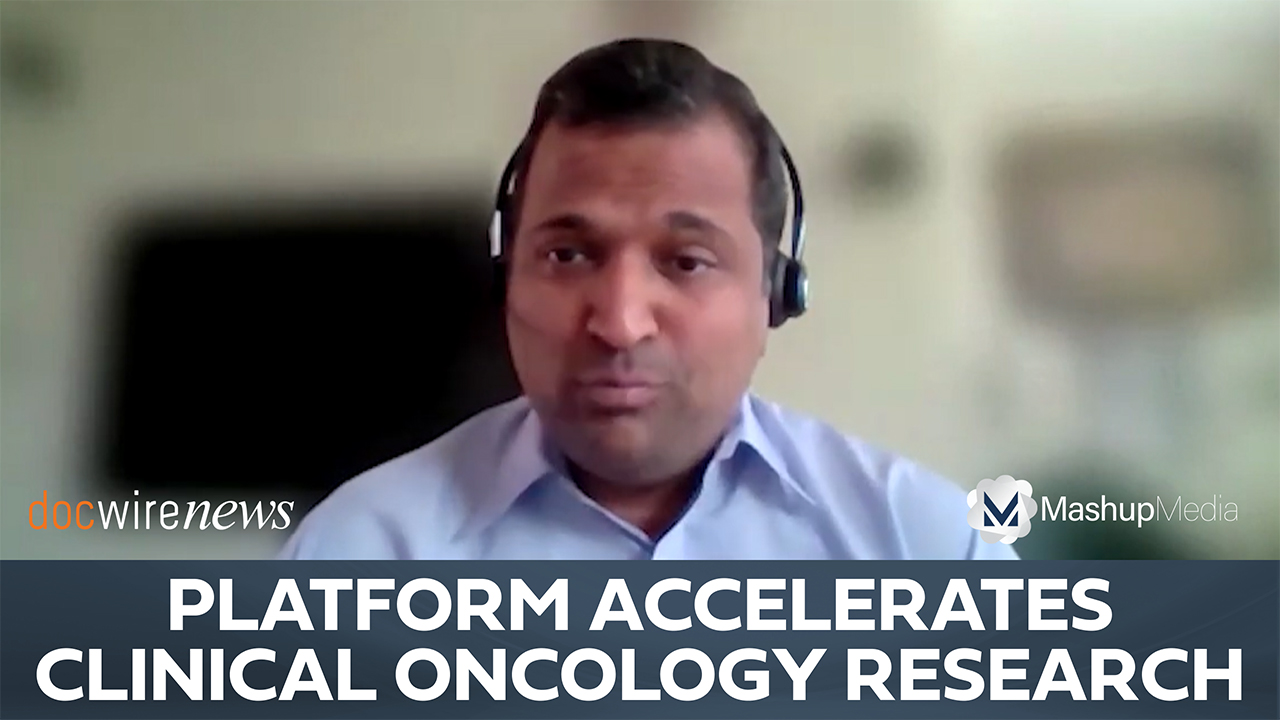Rick Anderson, DarioHealth: Providing Digital Solutions for Chronic Conditions
By Rob Dillard - Last Updated: August 1, 2023DarioHealth is a digital therapeutics company that develops devices and software to help people manage chronic health conditions. They aim to make it easy for people to care for their health by way of providing continuous support that anticipates and understands user needs.
DocWire News spoke with Rick Anderson, President & General Manager North America at DarioHealth, about what differentiates Dario from the pack, which conditions they specialize in managing, and about the data that back their technology.
DocWire News: Tell us about DarioHealth and your role with the company.
Rick Anderson: Sure. DarioHealth is a digital therapeutics company, which fundamentally means we use devices and software to help people manage their chronic conditions. Right now, we are doing diabetes, prediabetes, hypertension, musculoskeletal, so think orthopedic kinds of things like physical therapy, and then behavioral health. Dario started, actually, as a direct-to-consumer company, so we like to say we solved the hardest problem first. How do you get individuals to engage with what you’re doing? And we were maintaining about an 80% retention of members on the platform, so really helped to learn how to give value to members on an ongoing basis. Because when you’re in a direct consumer point of view, people aren’t going to pay out of their own pocket for a solution unless you’re providing value. And learning that upfront enabled the company to better understand how to serve members going forward and really engage with those members, which is important.
Then the company added to that, the hypertension, and the prediabetes, and weight management platform, and I actually joined the company at the beginning of 2020, in order to lead the transition from just being a direct-to-consumer company, which we remain a direct-to-consumer company, into what we call the B2B business, which is health plans, employers and providers, where we’re taking our solutions and providing them to those folks as well, or their members and employees as part of that. So, my primary role was really leading that transition from a market perspective, sales, customer support, and operations.
How is DarioHealth different from other digital therapeutic companies?
So, I think that there’s a number of things, but I’ll highlight three things. One is that we took the approach coming from the direct-to-consumer background that enabled us to collect a lot of data. Even early on in the process, we were collecting more than 5 billion data points a year, and then to build an AI engine that enables us to personalize the solution to members. And lots of people talk about the fact they personalize, or they fingerprint the solution, and really what people mean is, if you look like a person who’s in group A, you get group A’s journey through the process, because you look like them. And what Dario does that’s a little bit different is, we will fingerprint people up front. So, we’ll say, “Hey, Rob looks like group B.” So, you’re going to start with the journey that group B would get, but actually what it does is it dynamically personalizes across six domains, which include content, tone, channel of delivery, etc., and it constantly looks at what a member’s responding to. So, it allows that journey to not stay static, but actually change over time.
So, our competitors may have some personalized messages that go in there, but fundamentally, your journey stays the same. And why is that important? Well, if you want to engage people and keep them on a platform, you want to help them with their ability to manage their chronic condition, you need to change with them. And we all change all of the time across multiple different things. Where are we in our disease? Were we diagnosed yesterday, or 10 years ago? A big difference in where people are. And then, how does that evolve over time? How did my knowledge base move? How do what I want to do with my given condition, how does that change over a period of time? And then we also have things that happen.
So, for example, if you tweak your back, if you’re a diabetic and you tweak your back, now you’re focused on your back pain. So, really trying to have a solution that’ll help you with MSK can be important for, that rather than just pinging somebody and say, “Hey, take a measure, take a measure, take a measure,” that actually turns people off. It’s what we call a known exit point. And, if you’re going to keep people on the platform, you have to be able to engage them and give them meaningful information at every interaction that you have with them. And so that dynamic personnel personalization enables you to do that.
A couple other things is one, just the breadth of our platform at this point. So, we have a broad-based platform, moreso than most of our competitors out there, given the conditions that I mentioned earlier that we’re covering. And the fact that we integrate those conditions together, I think, is the last thing that’s really different, in that it’s one journey, one coach, you move back and forth between those conditions, if you have it. And most of the people that have one of these conditions has more than one of the conditions. And that’s part of the reason we chose the conditions we did that we have on the platform, is there’s a high level of comorbidity or coexistence of those conditions inside the members.
So, competitors will tend to have one, two, or three solutions. They might have point solutions, or they might have multiple point solutions, but they’re modules. So, you’ll have different coaches, you’d have a different journey. You’d have to go to different places in order to manage if you have different conditions. Whereas within Dario, I like to refer to it, it’s like the department store model. If I want to go to the men’s store, I can go through the door that goes directly into the men’s store, but hey, if I want to go to the luggage department, I can walk over, go up the escalator, without going out of the store, and I have everything readily contained in one place where I can access it easily. And I think that that is also a big differentiator in what Dario is doing.
DarioHealth began in diabetes and expanded to multiple chronic conditions. What was the reason for this?
Primarily, what I mentioned earlier, which is that we recognize that the folks that we’re helping manage their conditions, tend to have multiple conditions. And how do you make it easy for them, and how do you make it easy to change their behaviors, and how do you understand it and work with the fact that these conditions are happening simultaneously with them? So, when we evaluate what conditions we want to add to the platform, we look at, is it a pain point for our customers? Which usually means it’s either a challenging condition that they’re dealing with, or in the case of the B2B customers, health plans, employers, for example, it’s costing them a lot of money. Is it comorbid with the other conditions that we have on the platform? So, depending on how you look at it, 25 to 45% of all people with chronic conditions have some level of behavioral health. Now, that doesn’t mean at a very high level or at high acuity level, but depression and anxiety pretty much coexist with chronic conditions, especially on an episodic basis over time.
And then the last thing that we really look at is, is behaviors a driver in the outcome? So, things like diabetes, behavioral health, MSK, are all things where, if you can change a member’s behavior or help them change their behavior, then you can actually improve their clinical outcomes. If you improve their clinical outcomes, and you can improve the cost profile as well associated with that. So those are the three things that we look at when we decide what we’re going to add.
How does the Dario platform use artificial intelligence to promote sustained behavior change in users?
That’s really all about the dynamic personalization. So, collecting the data and understanding how members are interacting with the platform, and then being able to use that on a dynamic basis to serve up content in a way that people can best consume it. And that’s how you provide value to members. If you provide value to members, they’ll stay on the platform, they’re more likely to change behavior. If they change behavior, they’re more likely to have better clinical outcomes, which is really the reward cycle that helps itself and continues forward. And then with each interaction we generate more and more information that the AI engine uses to do that dynamic personalization.
DarioHealth has conducted numerous clinical studies. Tell us about them and the value they have.
So, we really have looked at each of the conditions where we have a point solution. So, if you look at diabetes, for example, we have a couple of studies that are very large and long-term, which I think is also unique, in terms of versus our competitors. So almost 40,000 people in a couple of those studies two years in length, looking at reduction in HBA1C, where we’re seeing about a 1.4% reduction in HBA1C, our next best competitors are usually going to be in the 0.8 or 0.9, so we’re significantly above that.
But we also have clinical endpoints around time in range, and some of the other diabetes measures. For hypertension, we’re looking at what are the reductions in the level of hypertension in conditions? We can actually get a whole condition reduction in some cases around that. And then for MSK, we’re measuring pain reduction and intent for surgery reduction over a period of time. And we’ve got studies that show that we’ve had significant reductions with that. And then on the behavioral health side, especially measuring anxiety and depression based on standardized scales, we’ve been able to demonstrate both with people with high acuity, as well as moderate acuity, that we can see significant reductions in depression and anxiety in the patients on the platform. And we’ve also recently had studies that are also showing multi-conditions on the platform that we’re able to address at the same time.
The latest study published in the Journal of Medical Internet Research focused on the impact of a multi-condition digital therapeutics platform. Tell us about what the study showed and the importance of these results.
Yeah, what the study really showed is that we could have an impact on clinical outcomes for members with diabetes and hypertension. So, two conditions on the same platform. And really, I think the importance of that is, it ties back to the facts that most people who have one of these conditions tend to have multiples of these conditions. And there’s an assumption if you don’t have a multi-condition platform, that people will use different platforms to manage those conditions, but there’s no evidence that really suggests that you can have people use those and see reductions. And what we’re showing in this study is we can use one platform and impact multiple conditions at the same time, which is a strong endorsement for having an integrated platform like this.
Any closing thoughts?
Well, thank you very much for having me on. I think that a couple of things that I think are important as we look forward in the industry, one is the importance of digital health versus telehealth. Telehealth in our view is a subsegment of digital health, but telehealth, which saw a big surge during the pandemic. And I’m hoping that that surge will continue because I think that what we saw was a lot of the issues people thought they’d have with telehealth but didn’t. People actually liked telehealth. It’s more convenient, you can reach more people. but some of the challenges with telehealth that it doesn’t solve for us, it doesn’t really solve for all of the access issues or the cost issues, because you still have to have a one-to-one connection, you still have to have a high-speed internet connection, and they happen still on a periodic basis, much like a face-to-face doctor’s visits.
Where digital health, I think is really going in the ability that it has to help people in the future, is that chronic conditions are what happened between your doctors’ visits. And digital health solutions can be there with you to help you manage those in between that, and then inform the doctors in terms of what your health looks like in between those. It’s not just a set of labs or just one measurement, it can let people look at things and how they transpire over time. It can be asynchronous or synchronous. So, what that means is you can do one to many, or many to many types of communications and provide value that way, which helps with both access and cost. And you don’t have to have a high-speed internet connection.
We actually have data on our platform that would suggest that people are using our solutions when they connect periodically to Wi-Fi. So, perhaps they’re going into the local Starbucks, or Burger King, or whatever it is, where they have a free Wi-Fi and they’re using that as the method to communicate with the platform, they download the information, they get the content that they need from that, and then they move on to the next time that they would interact with that. So, we really believe that there is a huge opportunity going forward. And we recently announced a partnership with Sanofi, and I think that that’s a validation of the fact that when we’re starting to see pharma come into the digital health market and really say, “Hey, we think that this is a market that’s here to stay, and it’ going to continue to grow,” and that’s what we believe as well.







 © 2025 Mashup Media, LLC, a Formedics Property. All Rights Reserved.
© 2025 Mashup Media, LLC, a Formedics Property. All Rights Reserved.